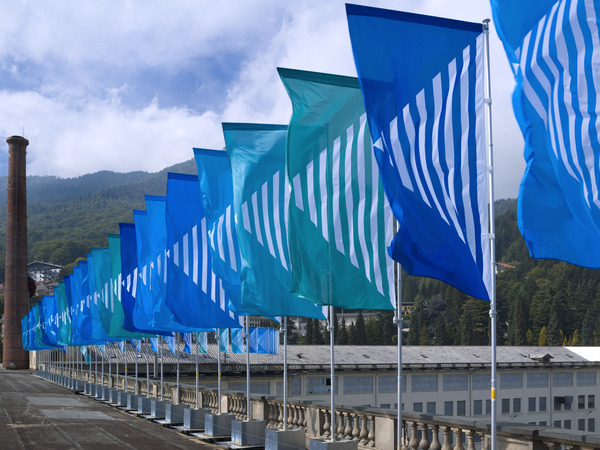
Italian luxury menswear brand Zegna unveils a defining chapter in its century-long commitment to art with a global multi-year partnership with Art Basel. The collaboration reinforces Zegna’s quiet yet profound belief in art as a transformative force in the intersection of creativity, community, and nature.
This is not a sudden foray into the cultural sphere for Zegna, but rather, a natural evolution for the brand. Art has long been embedded into its very fabric as part of a language of values. It was Ermenegildo Zegna, the brand’s founder, who first weaved this relationship into being in the 1920s. As part of his philosophy of giving back to the land that shaped him, he commissioned local artists—among them Ettore Pistoletto Olivero and Otto Maraini—to enrich the town of Trivero and the original wool mill that's still at the heart of Oasi Zegna today.

These artistic commissions were never mere gestures of grandeur. Monumental staircases, carved fountains, expressive friezes and quietly elegant portraits all emerged as expressions of Zegna’s founding ethos that industry and aesthetics are not opposing forces. Over time, this discreet commitment blossomed into an ongoing dialogue. Without overt branding or spectacle, Zegna supported site-specific works by the likes of Daniel Buren, Dan Graham and Roman Signer—artists chosen for their ability to interpret Zegna's ethos authentically. The brand’s stores and headquarters both carry this legacy forward, housing works by William Kentridge, Mimmo Jodice and Kiki Smith, among others.
As Art Basel continues to anchor the world’s contemporary art calendar, Zegna’s partnership positions the brand at the very centre of these creative conversations. This global partnership will unfold across the four major fairs—Basel, Miami Beach, Paris, and Hong Kong—through thoughtful, immersive experiences to spark dialogue between art, design, and responsible entrepreneurship. “Visible”, a pioneering project from Cittadellarte-Fondazione Pistoletto and Fondazione Zegna that supports artists whose work addresses urgent environmental and social challenges, will be a key landmark.

The bond between Zegna and the Pistoletto legacy is both historic and profound. "Visible" also pays tribute to Michelangelo Pistoletto—renowned artist and Nobel Peace Prize nominee—whose father, Ettore Pistoletto Olivero, was among the first artists commissioned by Zegna. That early collaboration sowed the seeds for a lasting, multi-generational dialogue between a fashion brand and a family of artists united by a shared vision of social transformation.
As Gildo Zegna, chairman and ceo of the Ermenegildo Zegna Group, aptly expresses: “At Zegna, we see art not as embellishment, but as an agent of change. By supporting socially engaged artists through the 'Visible' project, we’re reinforcing our commitment to a future where creativity, community, and responsibility can thrive together.”

As part of this deepened alliance, Vincenzo De Bellis, Art Basel director of fairs and exhibition platforms, will join the Visible Steering Committee. He says, “Through this partnership with Zegna and Cittadellarte–Fondazione Pistoletto, we’re supporting artists who use their practice to address today’s most urgent challenges and shape more resilient futures.”
To mark this significant milestone, Zegna will release a special-edition tote bag that embodies the brand’s ongoing conversation between nature, culture, and responsible progress. Featuring original illustrations by artist Cecilia Carlstedt taken from the Born in Oasi Zegna book, the design captures the poetic synergy between landscape and legacy.
It’s this shared vision that makes this partnership different. Zegna isn’t seeking cultural cachet, it’s offering space. And perhaps that’s what makes this moment so compelling. Because ultimately, legacy isn’t what you build for the sake of it. It’s what you leave behind with care. And Zegna? It’s leaving something that speaks.